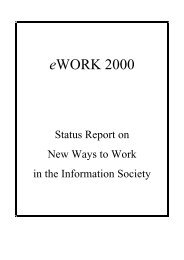Proceedings of 8th European Assembly on telework (Telework2001)
Proceedings of 8th European Assembly on telework (Telework2001)
Proceedings of 8th European Assembly on telework (Telework2001)
You also want an ePaper? Increase the reach of your titles
YUMPU automatically turns print PDFs into web optimized ePapers that Google loves.
185Since technological reas<strong>on</strong> in generalised versi<strong>on</strong> is <strong>on</strong> the decline, focus is shifting towardsspecific success as the main source <str<strong>on</strong>g>of</str<strong>on</strong>g> legitimacy to organise. Legitimacy has to be built <strong>on</strong> c<strong>on</strong>cretecircumstances and can generally be built up <strong>on</strong>ly within the framework <str<strong>on</strong>g>of</str<strong>on</strong>g> specific organisati<strong>on</strong>s,processes or movements.This creates, <strong>on</strong> the other hand, a challenge. While there is, <strong>on</strong> the <strong>on</strong>e hand, a drift towardsthe c<strong>on</strong>crete and c<strong>on</strong>textual in the generati<strong>on</strong> <str<strong>on</strong>g>of</str<strong>on</strong>g> legitimacy to organise, there is an obvious needto organise “larger systems”. In a globalized ec<strong>on</strong>omy with l<strong>on</strong>g and complex value chains,with clusters, networks, industrial districts and regi<strong>on</strong>s as core units <str<strong>on</strong>g>of</str<strong>on</strong>g> development, numerousrelati<strong>on</strong>ships <str<strong>on</strong>g>of</str<strong>on</strong>g> organisati<strong>on</strong> cross the boundaries <str<strong>on</strong>g>of</str<strong>on</strong>g> the individual enterprise. There is a growingneed for actors in the terrain between the enterprises and there is an associated need for new forms<str<strong>on</strong>g>of</str<strong>on</strong>g> legitimacy.The need for legitimacy emerging <strong>on</strong> this in-between level cannot automatically be supplied byactors whose success have emerged within the framework <str<strong>on</strong>g>of</str<strong>on</strong>g> <strong>on</strong>e single organisati<strong>on</strong> since thechallenge is, after all, to organise relati<strong>on</strong>ships between organisati<strong>on</strong>s. What can not be provided byindividual enterprises is <str<strong>on</strong>g>of</str<strong>on</strong>g>ten thought to be provided by the nati<strong>on</strong> state. The classical argumentis that the nati<strong>on</strong> state is “superior” to everybody else and hence able to organise not <strong>on</strong>ly itself butalso everybody “below”. Even the actors <str<strong>on</strong>g>of</str<strong>on</strong>g> the nati<strong>on</strong> state are, however, facing problems:For “the nati<strong>on</strong> state” to hold the legitimacy to organise it must, itself, act in a reas<strong>on</strong>ablyc<strong>on</strong>sistent way. The traditi<strong>on</strong>alist, but stable, nati<strong>on</strong> state is, however, replaced by the theme<str<strong>on</strong>g>of</str<strong>on</strong>g> the m<strong>on</strong>th, the face <str<strong>on</strong>g>of</str<strong>on</strong>g> the week, the winner <str<strong>on</strong>g>of</str<strong>on</strong>g> this evening`s TV c<strong>on</strong>test. The nati<strong>on</strong> stateinitiates a vast number <str<strong>on</strong>g>of</str<strong>on</strong>g> efforts, in numerous spheres, through a large number <str<strong>on</strong>g>of</str<strong>on</strong>g> channelsand mediating bodies. When a c<strong>on</strong>tinuous stream <str<strong>on</strong>g>of</str<strong>on</strong>g> new policies are to be implemented, theimplementati<strong>on</strong> apparatus grows, however, more and more fragmented. The number <str<strong>on</strong>g>of</str<strong>on</strong>g> scenes fromwhich public representatives can express views <strong>on</strong> organisati<strong>on</strong> is numerous and there is practicallyno integrati<strong>on</strong> between them. The source <str<strong>on</strong>g>of</str<strong>on</strong>g> legitimacy is no l<strong>on</strong>ger the nati<strong>on</strong> state as such but thehistorical success or presumed abilities <str<strong>on</strong>g>of</str<strong>on</strong>g> those who are called <strong>on</strong> to act <strong>on</strong> behalf <str<strong>on</strong>g>of</str<strong>on</strong>g> the nati<strong>on</strong>state. In this way, the legitimacy to act <strong>on</strong> behalf <str<strong>on</strong>g>of</str<strong>on</strong>g> the nati<strong>on</strong> state becomes, like technologicalreas<strong>on</strong>, c<strong>on</strong>textualised and is no l<strong>on</strong>ger a universal characteristic <str<strong>on</strong>g>of</str<strong>on</strong>g> the nati<strong>on</strong> state.In organising “large systems” we face, to sum up, a triple challenge:• To create legitimacy to organise the terrain between the enterprises• under c<strong>on</strong>diti<strong>on</strong>s where c<strong>on</strong>crete success is a main basis for legitimacy• at the same time as there is a need for co-operati<strong>on</strong> between many different actors.What do the different societies do about this issue <str<strong>on</strong>g>of</str<strong>on</strong>g> links, ties and new forms <str<strong>on</strong>g>of</str<strong>on</strong>g> entrepreneurship?What initiatives are emerging for the purpose <str<strong>on</strong>g>of</str<strong>on</strong>g> forging together the various elements in, forinstance, “innovati<strong>on</strong> systems”?This is the point where such efforts as workplace development programs enter the scene. Adevelopment program is taken to mean a formalised co-operati<strong>on</strong> around the task <str<strong>on</strong>g>of</str<strong>on</strong>g> creatingdevelopment and innovati<strong>on</strong> in workplaces and enterprises and with a c<strong>on</strong>figurati<strong>on</strong> <str<strong>on</strong>g>of</str<strong>on</strong>g> actorsgenerally including private as well as public <strong>on</strong>es and from several different organisati<strong>on</strong>s and types<str<strong>on</strong>g>of</str<strong>on</strong>g> organisati<strong>on</strong>s. A program can be seen as corresp<strong>on</strong>ding to the noti<strong>on</strong> <str<strong>on</strong>g>of</str<strong>on</strong>g> “innovati<strong>on</strong> system”








